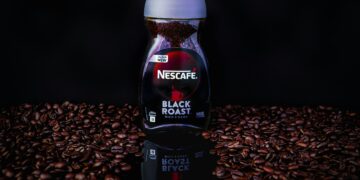Table of Contents
My journey with the Starbucks Cold Brew Pitcher Packs began, as I imagine it does for many, in the fluorescent-lit aisle of a grocery store.
There they were, nestled among the bags of whole beans and boxes of K-Cups, a beacon of hope in their familiar green and white packaging.
The promise was intoxicating: the smooth, rich cold brew I loved, the one that powered my afternoons and cost a small fortune daily, could now be mine at home.
For a fraction of the price and with minimal effort, I could have a pitcher of my favorite coffee ready and waiting in the fridge.
I grabbed a box, feeling like I had discovered a life hack of the highest order.
That feeling, however, was fleeting.
My first attempt was a study in disappointment.
I followed the instructions on the box with the precision of a scientist.1
Two pitcher packs into four cups of water, a 24-hour steep in the fridge, a final dilution with three more cups of water.
The result? A pale, insipid liquid that tasted more like “coffee-flavored water” than the bold brew I craved.3
Undeterred, I tried again.
Maybe I had done something wrong.
But the second batch was a different kind of failure—this time, a harsh, bitter bite assaulted my palate, a far cry from the “subtly sweet chocolaty notes” promised on the box.2
This cycle of hope and frustration became a familiar routine.
I was following the rules, yet the outcome was a lottery of bad coffee.
I scoured online forums and found I wasn’t alone; a chorus of fellow coffee lovers shared my pain, complaining of weak, bitter, or sour results that were nothing like the smooth, consistent cold brew served in Starbucks cafes.2
It was maddening.
I felt let down by a brand I trusted.
But more than that, I was determined to understand
why.
It wasn’t just about getting a decent cup of coffee anymore; it was about solving the puzzle.
This article is the story of that quest—a journey from a frustrated consumer to an empowered brewer, a deep dive into the science of why this seemingly simple product so often fails, and the ultimate discovery of a method that finally unlocks its promise.
Part I: The Promise and the Problem: A Deep Dive into the Pitcher Pack Experience
The Allure of Convenience: What Starbucks Sells You
The appeal of the Starbucks Cold Brew Pitcher Packs is rooted in a powerful and simple proposition: cafe-quality coffee with at-home convenience.
Starbucks markets the product as an effortless way to achieve a “bold, super-smooth, cold coffee you can enjoy all week long”.4
The instructions, printed plainly on the box, reinforce this message of simplicity.
The official process involves a few straightforward steps:
- Drop two pitcher packs into a pitcher.
- Add 4 cups of cold, filtered water.
- Steep in the refrigerator for 24 hours.
- Gently remove the pitcher packs.
- Add 3 cups of cold, filtered water to the resulting concentrate.
- Stir and serve over ice.1
This method promises to yield four 12 fl oz glasses, making the cost—typically between $9.99 and $11.99 per box—highly attractive compared to a daily cafe habit that can easily exceed $5 per cup.1
Its wide availability in most major supermarkets makes it an easy impulse buy for any Starbucks loyalist.
In fact, the product is popular enough that occasional stock shortages have been known to cause a stir among its fans, creating a sense of scarcity and demand.9
The product itself is identified as “Signature Black,” a medium roast, pre-ground coffee blend specially developed for brewing cold.4
This pre-ground nature is presented as a key feature of its convenience—no grinder, no measuring, no mess.
As we will see, this very feature is also the source of its greatest weakness.
The Bitter Reality: An Autopsy of a Bad Brew
Despite the promise of simplicity and quality, the real-world experience for many users is one of frustrating inconsistency.
A survey of user reviews and online discussions reveals a consistent pattern of complaints that stand in stark contrast to the marketing claims.
The most common issues include:
- Weak and Watery Brews: Many users report their final product tasting like “iced tea” or “coffee flavored water,” lacking the body and richness expected of cold brew.3 Some long-time users have even noted a perceived decline in quality over the years, suggesting potential changes to the product’s formulation or the coffee blend itself.3
- Bitter and Sour Tastes: Perhaps more frustrating is the frequent emergence of a harsh, “bitter taste”.2 This is often the primary complaint, as cold brew’s main appeal is its lower acidity and lack of bitterness compared to hot-brewed coffee. In some cases, this bitterness is accompanied by an unpleasant “sour taste,” a clear sign of a flawed extraction.6
- Inconsistency: The core problem that ties all these issues together is the lack of predictability. A user can follow the exact same steps and get wildly different results from one batch to the next. This unpredictability undermines the product’s core value proposition of reliability.
- Not Like the “Real Thing”: A crucial point of disappointment for many is the significant taste difference between the at-home product and the cold brew served in Starbucks cafes. Reviewers often describe the pitcher pack version as a “far cry from the smoother black cold brew they have in store,” creating a disconnect between the brand’s reputation and the product’s performance.2
My own journey was defined by this inconsistency.
I’ll never forget one particular Saturday morning.
I had a fresh box of pitcher packs and was determined to get it right.
I used filtered water from a freshly changed pitcher, a glass container I had meticulously cleaned, and a timer set for exactly 24 hours.
I followed every step on the box to the letter.
The next day, I removed the packs with the gentle care of a surgeon and added the prescribed three cups of water.
I poured it over ice with a sense of anticipation, only to be met with a taste that was somehow both thin and acrid.
It was a confusing, disheartening result that perfectly encapsulated the product’s central flaw: following the rules was no guarantee of success.
Adding to the frustration are physical defects with the product itself.
Several users have pointed out that the paper-mesh filter bags are incredibly fragile and prone to rupturing, spilling coffee grounds throughout the pitcher and creating a gritty, undrinkable mess.2
This points to a quality control issue that extends beyond the coffee itself, compounding the user’s frustration.
Part II: The Epiphany: Cold Brew Isn’t a Recipe, It’s a Reaction
For weeks, I treated the pitcher packs like a cake mix.
I assumed that if I combined the fixed ingredients according to the instructions, a consistent and delicious result would emerge.
My repeated failures proved this assumption was fundamentally wrong.
The real turning point—my epiphany—came from a place you might not expect: my old college chemical engineering textbooks.
The Brewer’s Epiphany: A Lesson from Chemical Engineering
As I puzzled over my weak, bitter coffee, I was reminded of a core principle from process engineering: you can’t control the outcome of a reaction without controlling the variables.
I realized I had been thinking like a cook following a recipe, when I needed to be thinking like an engineer managing a slow, cold-water extraction.
Brewing coffee isn’t magic; it’s a chemical process where water acts as a solvent to pull soluble compounds out of solid coffee grounds.
The instructions on the box weren’t a sacred law; they were a single, highly simplified data point in a complex multi-variable equation.
They assumed a perfectly stable, unchanging environment that simply doesn’t exist in the real world.
To get consistent, high-quality results, I had to stop blindly following the recipe and start actively managing the reaction.
The Science of Extraction: Your Guide to Flavor Control
To control the reaction, I first had to understand it.
Coffee extraction is the process of dissolving the flavor compounds from coffee grounds into water.
The key is that different compounds extract at different rates, in a predictable sequence.11
- First come the acids and fats: These are highly soluble and extract quickly, contributing bright, fruity, and sour notes.
- Next come the sugars: These take a bit longer and are responsible for the sweetness and body of the coffee.
- Last come the plant fibers: These are the least soluble compounds and contribute the deep, bitter flavors.
The goal of any brewing method is to hit the “sweet spot”—extracting enough of the acids and sugars for complexity and sweetness, but stopping before you extract too many of the bitter compounds.
This leads to the two cardinal sins of coffee brewing:
- Under-extraction: If you don’t brew long enough or your grind is too coarse, you pull out the acids but not enough of the sugars. The result is a coffee that tastes sour, thin, and weak.
- Over-extraction: If you brew for too long or your grind is too fine, you pull out all the good stuff and then keep going, extracting the undesirable bitter compounds from the plant fibers. The result is a coffee that tastes harsh, bitter, and dull.
This delicate balance is governed by four key variables.
For the pitcher packs, understanding them is the key to unlocking the puzzle.
- Grind Size (The Unchangeable Flaw): This is the most critical variable. The total surface area of the coffee grounds dictates how quickly water can extract flavor. Cold brew requires a very coarse and consistent grind to allow for a long, slow, even extraction.13 The Starbucks Pitcher Packs, however, contain pre-ground coffee. Like most pre-ground coffee, it is not perfectly uniform. It contains a mix of particle sizes, from large “boulders” to fine “dust”.12 This is the product’s Achilles’ heel.
- Coffee-to-Water Ratio (The Key to Control): This ratio determines the starting concentration of your brew. Using less water for the same amount of coffee creates a stronger, more concentrated brew, which can help pull more flavor from the grounds.14 This is the most powerful variable we can easily manipulate with the pitcher packs.
- Steep Time (A Balancing Act): A longer steep time generally means more extraction.13 However, with the flawed grind of the pitcher packs, extending the time is a double-edged sword. It might help extract more flavor from the coarse particles, but it also gives the fine particles more time to release their bitter compounds.
- Water Temperature and Quality: Cold brew famously uses time instead of heat. Steeping in a cold refrigerator significantly slows down the extraction process compared to steeping at room temperature.13 Using filtered water is also crucial, as impurities in tap water can introduce unwanted flavors and interfere with proper extraction.13
Diagnosing the Defect: Why the Box Recipe Fails
Armed with this new understanding, the reason for my frustratingly inconsistent results became glaringly obvious.
The “weak and bitter” paradox wasn’t a random fluke; it was the direct, predictable outcome of the product’s design clashing with the laws of chemistry.
The inconsistent pre-ground coffee is the original sin.
When you steep it for the recommended 24 hours, two things happen simultaneously.
The fine dust particles, with their massive surface area, extract very quickly and begin to over-extract long before the 24-hour mark is up.
They are the source of the harsh, unpleasant bitterness that plagues so many batches.
At the same time, the large, coarse “boulder” particles, with their low surface area, struggle to extract fully in the cold water.
Over the same 24 hours, they under-extract, failing to release enough of their sugars and oils.
They are the source of the weak, watery body.
The result is a flawed concentrate that is simultaneously over-extracted (bitter) and under-extracted (weak).
The final instruction—to dilute this mess with a fixed volume of three cups of water—is the final nail in the coffin.
It does nothing to fix the underlying imbalance; it simply waters down the entire concoction, often making the weakness more apparent while doing little to mask the bitterness.
The product fails because its one-size-fits-all recipe cannot possibly account for the chaotic, uneven extraction caused by its primary ingredient.
Part III: The Solution: The “Pitcher Perfect” Method for Flawless Starbucks Cold Brew
The moment I understood the problem, the solution became clear.
If the box recipe was the problem, I needed to write a new one.
I needed a method that acknowledged the product’s inherent flaw—the pre-ground coffee—and used the variables I could control to compensate for it.
After several rounds of experimentation, I landed on what I call the “Pitcher Perfect” Method, a simple set of adjustments that has delivered consistently smooth, rich, and delicious cold brew every single time.
The New Rules: A Step-by-Step Guide to Taking Control
This method is about making small but critical changes to the official instructions to steer the chemical reaction toward a better outcome.
- Step 1: Change the Ratio (The Master Hack). This is the single most important change. Instead of the 4 cups (32 fl oz) of water called for in the instructions, use only 3 cups (24 fl oz) of cold, filtered water for the initial steep. By reducing the amount of water, you increase the coffee-to-water ratio. This creates a more potent concentrate, forcing the water to work harder and extract more of the desirable flavor compounds from the under-extracting coarse particles.14
- Step 2: Ensure Full Saturation. When you place the two pitcher packs in the water, don’t just let them float. Gently push them down with a spoon until they are fully submerged and all the grounds are wet. Air pockets and floating bags are a primary cause of under-extraction.16
- Step 3: Adjust the Time (Optional Fine-Tuning). Steep the concentrate in your refrigerator for 20 to 24 hours. The 24-hour mark is generally fine, but if you find your brew is still a little too bitter for your taste, you can dial back the steep time to 18 or 20 hours. This gives the bitter “fines” less time to over-extract while still allowing the new, stronger ratio to work its magic on the coarse grounds.3
- Step 4: Handle with Care. The filter bags are notoriously fragile.3 When your steep is complete, remove the packs gently.
Do not squeeze them. Squeezing forces out the last dregs of liquid, which are often the most bitter, and dramatically increases the risk of the bag tearing and flooding your beautiful concentrate with grounds.13 Let them drain naturally for a moment, then discard them. - Step 5: Dilute to Taste (The Most Important Step). This is where you take final control. Ignore the box’s instruction to add 3 cups of water. You have created a custom concentrate, and you will now dilute it to your personal preference. Start by pouring your concentrate over a glass full of ice. Then, slowly add cold, filtered water (or your milk of choice), tasting as you go. A good starting point is a 1:1 ratio of concentrate to water, but you are the final judge.17 This final step ensures the coffee is never too weak or too strong, but exactly right for you.
The Perfected Pitcher Pack Recipe
To make the changes clear, here is a direct comparison of the official method and my perfected method.
| Variable | Official Instructions (On the Box) | The “Pitcher Perfect” Method (My Recommendation) | Why It Matters |
| Initial Water | 4 cups (32 fl oz) | 3 cups (24 fl oz) | Creates a stronger concentrate to combat under-extraction from coarse grounds. This is the most critical hack. |
| Steep Time | 24 hours in fridge | 20-24 hours in fridge | Provides a window to fine-tune the brew. Reduce time toward 20 hours if the result is too bitter. |
| Handling | “Gently remove pitcher packs” | Gently remove, DO NOT squeeze | Squeezing forces out bitter compounds from over-extracted fines and risks tearing the fragile bags.13 |
| Dilution | Add 3 cups (24 fl oz) of water | Dilute to taste (start with 1:1 ratio) | Puts you in control of the final strength, eliminating the risk of a watery, pre-diluted pitcher.18 |
| Final Strength | Fixed and often weak | Customizable to your preference | You decide how bold your final cup is, ensuring it’s never too weak for your liking. |
Troubleshooting Your Brew: A Dial-In Guide
Even with the perfected method, small variations in your fridge temperature or water can have an effect.
Here’s a quick guide to dialing in your brew perfectly.
- If it tastes weak or watery… Your concentrate isn’t strong enough. This is less likely with the new ratio, but if it happens, ensure the packs were fully submerged and not floating. On your next batch, let it steep for the full 24 hours.
- If it tastes bitter… You are over-extracting the fine particles. On your next batch, reduce the steep time to 18-20 hours. Be extra gentle when removing the packs to avoid agitation.
- If it tastes sour… You are severely under-extracting. This is the least common problem but can occur. Make sure you are using the reduced 3-cup water ratio and steeping for at least 20 hours.
Part IV: The Cold Brew Landscape: Graduating Beyond the Pitcher Pack
Mastering the Starbucks Pitcher Packs is a rewarding feeling, but it’s also a gateway.
Once you understand the principles of extraction, a whole world of superior coffee opens up.
The pitcher packs are an exercise in damage control; making cold brew from scratch is an exercise in total creative freedom.
Level Up: The Art of “From Scratch” Cold Brew
The single greatest leap forward you can make in your coffee journey is to buy whole beans and grind them yourself just before brewing.
This gives you direct control over the most important variable in the entire process: grind size.12
- The “From Scratch” Toolkit:
- Beans: You can start with a familiar taste by using Starbucks’ own Espresso Roast (a dark roast) or their Siren’s Blend, which is reportedly the backup for their in-store cold brew.16 Many baristas and home brewers also recommend medium-roast African or Colombian beans for their bright, complex notes.20
- Grind: This is non-negotiable. You need a coarse grind, with particles roughly the size of coarse sea salt or breadcrumbs.13 A fine grind will result in a bitter, silty mess.
- Ratio: A common and effective starting ratio for a cold brew concentrate is 1:8 coffee-to-water by weight (e.g., 100 grams of coffee to 800 grams of water).22
- Method: You don’t need fancy equipment. A large mason jar and a filter are all it takes. You can use a simple cheesecloth, a reusable nut milk bag, or even a paper filter set in a strainer to filter the grounds after steeping.20 A French press also works beautifully for both steeping and filtering.24
Making your own cold brew from scratch is not only a step up in quality and control, but it’s also far more economical.
A pound of whole bean coffee will yield significantly more concentrate than several boxes of pitcher packs for a comparable price.16
The Professional’s Choice: An Analysis of the Toddy System
If you’ve ever wondered how Starbucks achieves such a consistently smooth and clean cold brew in their cafes, the secret is a commercial-grade version of a device called the Toddy Cold Brew System.25
The Toddy is the gold standard for many coffee shops, and its design brilliance lies in how it solves the fundamental problem of cold brew filtration.
The home version of the Toddy system employs a unique dual-filtration process.
The coffee grounds are first placed inside a single-use paper filter bag.
This bag sits inside the brewing container, at the bottom of which lies a thick, reusable felt filter D.Sc. After steeping, the concentrate drains through the paper bag and then through the dense felt filter before exiting into a decanter.27
This two-stage system is what sets the Toddy apart.
The paper bag contains the vast majority of the grounds, making cleanup simple.
But the real magic happens at the second stage.
The thick felt filter is designed to trap the ultra-fine particles (“silt” or “dust”) and excess oils that inevitably escape the paper bag.
It is these fines that are the primary source of bitterness and muddy texture in other brewing methods.
By removing them, the Toddy produces a remarkably clean, bright, and smooth concentrate that is virtually free of sediment.32
It is an engineered solution to the core challenge of immersion brewing.
For the dedicated home brewer who makes cold brew in larger batches and demands the absolute highest, most consistent quality, the Toddy system is the ultimate upgrade.
At-Home Cold Brew Methods
To help you choose your path, here is a breakdown of the three methods we’ve discussed.
| Method | Initial Cost | Cost Per Serving | Effort/Time | Flavor Quality & Consistency | Level of Control | Best For… |
| Starbucks Pitcher Packs (Perfected) | Low (~$10) | Medium | Low (minimal prep, 24-hr steep) | Good, but limited by pre-ground coffee. Consistent with the “Perfected Method.” | Low (only ratio, time, and dilution are adjustable) | The convenience-seeker who wants a reliable, decent brew with minimal fuss and equipment. |
| DIY / Mason Jar Method | Low (~$15-25 for a jar and filters) | Low | Medium (requires grinding beans and manual filtering) | Excellent and highly customizable. Consistency depends on your process. | High (full control over beans, grind, ratio, and time) | The budget-conscious enthusiast who wants to experiment and values flavor quality over convenience. |
| Toddy System | Medium (~$40-50) | Low | Medium (requires grinding, but filtering is simplified) | Exceptional and extremely consistent due to dual-filtration. | High (full control, plus superior filtration) | The dedicated cold brew aficionado who makes larger batches and prioritizes the smoothest, cleanest, cafe-quality result. |
Conclusion: The Final Verdict on Convenience vs. Control
My journey with the Starbucks Cold Brew Pitcher Packs took me from a place of blind trust to frustrated confusion, and finally, to empowered understanding.
The product is not inherently “bad,” but it is built on a flawed premise.
It sells the dream of effortless perfection, but the reality of its pre-ground coffee makes that dream an impossibility without intervention.
The convenience it offers comes at the direct expense of control.
Following the instructions on the box is a gamble.
But as I discovered, you don’t have to play by those rules.
By understanding the simple science of extraction and taking control of the key variables—by thinking like an engineer, not just a cook—you can bend the product to your will.
The “Pitcher Perfect” method outlined in this guide transforms the pitcher packs from a source of frustration into a reliable tool for making genuinely delicious cold brew.
Ultimately, the choice is yours.
The pitcher packs, when hacked, can be a worthy and convenient part of your coffee routine.
But for those who fall in love with the process, who seek the sublime smoothness of a truly authentic cold brew, the path forward is clear.
It leads to whole beans, a coarse grind, and the deep satisfaction of crafting a perfect cup from scratch.
Whether you stick with the packs or graduate beyond them, you are now armed with the knowledge to succeed.
The choice between convenience and control is finally in your hands.
Works cited
- Starbucks Cold Brew Coffee Pitcher Pack Vanilla Fig Box – 4.83 Oz …, accessed July 29, 2025, https://www.randalls.com/shop/product-details.960520020.html
- Starbucks Cold Brew Pitcher Kit – Short Review : r/Coffee – Reddit, accessed July 29, 2025, https://www.reddit.com/r/Coffee/comments/4yecx7/starbucks_cold_brew_pitcher_kit_short_review/
- Customer reviews for Starbucks Cold Brew Coffee — Signature …, accessed July 29, 2025, https://www.walmart.com/reviews/product/379628488
- Starbucks® Cold Brew Pitcher Packs Ground Coffee, 2 ct – King Soopers, accessed July 29, 2025, https://www.kingsoopers.com/p/starbucks-cold-brew-pitcher-packs-ground-coffee/0076211121201
- Is the cold brew supposed to be EXTREMELY bitter?? : r/starbucks – Reddit, accessed July 29, 2025, https://www.reddit.com/r/starbucks/comments/xftgcf/is_the_cold_brew_supposed_to_be_extremely_bitter/
- Why does the cold brew taste bad now? : r/starbucks – Reddit, accessed July 29, 2025, https://www.reddit.com/r/starbucks/comments/165lype/why_does_the_cold_brew_taste_bad_now/
- How to Make Cold Brew Coffee at Home – YouTube, accessed July 29, 2025, https://www.youtube.com/watch?v=01cvqhTAGyQ
- Starbucks Cold Brew Coffee — Signature Black — Pitcher Packs …, accessed July 29, 2025, https://www.walmart.com/ip/Starbucks-Cold-Brew-Coffee-Signature-Black-Pitcher-Packs-1-box-makes-2-pitchers-total/379628488
- Your Favorite Cold Brew Pitcher Packs : r/coldbrew – Reddit, accessed July 29, 2025, https://www.reddit.com/r/coldbrew/comments/pb0970/your_favorite_cold_brew_pitcher_packs/
- Starbucks Cold Brew Pitcher Pack Shortage? : r/coldbrew – Reddit, accessed July 29, 2025, https://www.reddit.com/r/coldbrew/comments/ok915h/starbucks_cold_brew_pitcher_pack_shortage/
- Coffee Tastes Bitter? Here Why, And How To Fix It, accessed July 29, 2025, https://coffeebros.com/blogs/coffee/coffee-tastes-bitter-here-why-and-how-to-fix-it
- Having Trouble With Your Cold Brew Coffee? Here Are 5 Tricks To …, accessed July 29, 2025, https://www.javapresse.com/blogs/cold-brew/having-trouble-with-your-cold-brew-coffee-here-are-5-tricks-to-try
- Six Common Mistakes When Making Cold Brew Coffee, accessed July 29, 2025, https://groundsandhoundscoffee.com/blogs/recent-posts/six-common-mistakes-when-making-cold-brew-coffee
- Best Iced Coffee Recipe – How to Make Perfect Iced Coffee at Home – The Pioneer Woman, accessed July 29, 2025, https://www.thepioneerwoman.com/food-cooking/recipes/a11061/perfect-iced-coffee/
- Cold Brew Iced Coffee Concentrate Recipe – Kitchen Treaty, accessed July 29, 2025, https://www.kitchentreaty.com/how-to-make-cold-brewed-iced-coffee-concentrate/
- Make Starbucks Cold Brew Coffee at Home with This Copycat Recipe – Trip Of A Lifestyle, accessed July 29, 2025, https://www.tripofalifestyle.com/money/starbucks-cold-brew-coffee-recipe/
- How to Make Starbucks® Cold Brew Concentrates, accessed July 29, 2025, https://athome.starbucks.com/how-to-guide/how-make-starbucks-cold-brew-concentrates
- Do I need to dilute my cold brew with water, or is it okay to just add milk? – Quora, accessed July 29, 2025, https://www.quora.com/Do-I-need-to-dilute-my-cold-brew-with-water-or-is-it-okay-to-just-add-milk
- How does Starbucks do it?? : r/coldbrew – Reddit, accessed July 29, 2025, https://www.reddit.com/r/coldbrew/comments/1hz2cd5/how_does_starbucks_do_it/
- Coffee Beginner. Starbucks Cold Brew Copycat Recipe? – Reddit, accessed July 29, 2025, https://www.reddit.com/r/Coffee/comments/8p0dxb/coffee_beginner_starbucks_cold_brew_copycat_recipe/
- How to Brew Cold Brew with a Coffee Press | Starbucks, accessed July 29, 2025, https://athome.starbucks.com/brewing-guide/how-brew-cold-brew-coffee-press
- how do you guys make cold brew? : r/Coffee – Reddit, accessed July 29, 2025, https://www.reddit.com/r/Coffee/comments/oi7rm7/how_do_you_guys_make_cold_brew/
- How to make Cold Brew and Iced Coffee at home. ☀️ #Starbucks #ColdBr… – TikTok, accessed July 29, 2025, https://www.tiktok.com/@starbucks/video/7247574023960349998
- Make your own iced coffee/cold brew? Tell me everything : r/Frugal – Reddit, accessed July 29, 2025, https://www.reddit.com/r/Frugal/comments/1fe8lt5/make_your_own_iced_coffeecold_brew_tell_me/
- I’m in LOVE, with Toddy! – Hugh Eats With You, accessed July 29, 2025, https://hugheatswithyou.com/12-i-m-in-love-with-toddy
- Does anyone have a strong opinion on the toddy cold brew system? – Reddit, accessed July 29, 2025, https://www.reddit.com/r/coldbrew/comments/j1dbt5/does_anyone_have_a_strong_opinion_on_the_toddy/
- Toddy® Home Cold Brew System | Toddy Cold Brew Coffee, accessed July 29, 2025, https://toddycafe.com/product/toddy-cold-brew-system
- Brew Coffee with a Toddy® Cold Brew System – Rhino Coffee, accessed July 29, 2025, https://rhinocoffee.com/blogs/brew-guides/brew-coffee-with-a-toddy%C2%AE-cold-brew-system
- Toddy® Essential Brewer – Food Service Edition | Toddy Cold Brew Coffee, accessed July 29, 2025, https://toddycafe.com/product/essential-brewer-food-service-edition
- COLD BREW SYSTEM – Toddy, accessed July 29, 2025, https://toddycafe.com/downloads/toddy_retail_instructions.pdf
- Best Cold Brew with Toddy | Kaapi Machines, accessed July 29, 2025, https://kaapimachines.com/the-best-cold-brew-with-toddy/
- Why does cold brew taste different to other coffee brewing methods? – Perfect Daily Grind, accessed July 29, 2025, https://perfectdailygrind.com/2023/04/why-does-cold-brew-taste-different/
- The Toddy difference | Toddy Cold Brew Coffee, accessed July 29, 2025, https://toddycafe.com/the-toddy-difference
- The Toddy Brew System – Blue Bottle Reviews – YouTube, accessed July 29, 2025, https://m.youtube.com/watch?v=t6rCI5NOmNI&pp=ygUKI3RvZGR5Y2FmZQ%3D%3D






